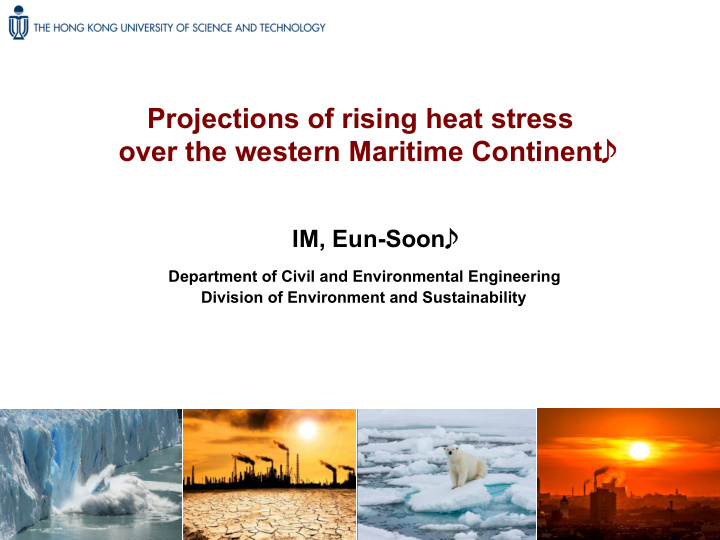



Toward More High-Resolution Projections of rising heat stress over the western Maritime Continent IM, Eun-Soon Department of Civil and Environmental Engineering Division of Environment and Sustainability
High Susceptibility to Global Warming v High signal-to-noise ratio for changes in surface temperature • The temperature increase expected from anthropogenic emission forcing is large relative to the model uncertainty and the natural variability. • The background “noise” induced by internal variability is lower in the tropics than elsewhere around the world. (Hawkins & Sutton 2009; Harrington et al. 2016) • The low-latitude countries around tropical areas exhibit the most imminent and robust emergence of hot temperature extremes . (King et al., 2015; Mahlstein et al., 2011) [Adapted from IPCC AR5] v Humid and hot climate in the present day • The humid and hot tropical climate is particularly vulnerable to the increasing temperature because even modest warming may exceed the critical level of heat stress and become more dangerous and intolerable. • Heat events may worsen more in humid tropical regions even if it warms less than the global average, due to greater absolute humidity increases. v Low socioeconomic status • Poor populations in areas of low socioeconomic status will be more likely to be adversely affected by extreme heat events. • The capacity to adopt and manage the risks of extreme heat is often limited in the tropics.
Concept of Wet-Bulb Temperature Hot & Wet Hot & Dry TW TW RH=70.7% RH=23.5% Td Tw Td Tw • Wet-bulb temperature is particularly useful in human health applications associated with heat stress, because evaporation is the primary means by which bodies cool in hot environments; thus, when Tw is high, evaporative cooling is restricted and the body core temperature may rise (Davis et al. 2016). • 35°C is the threshold value of TW beyond which any exposure for more than 6-hour would likely be intolerable even for the fittest of humans resulting in hyperthermia. In current climate, TW rarely exceeds 31°C .
Various Metrics of Moist Temperature v Wet-bulb temperature (T w ) • Tw is the temperature at which air becomes saturated by evaporation at constant pressure. • Tw is empirical value to which a wetted thermometer will drop under vaporation. • Tw is particularly useful in human health applications associated with heat stress, because evaporation is the primary means by which bodies cool in hot environments. [From Stull 2011] 𝑈↓𝑥 = 𝑈 − ( 𝑈 − 𝑈↓𝑒 )∗(0.12+0.008∗ 𝑈 ) [ From Anderson 1968] v Apparent temperature (T app ) • T app combines temperature and humidity into a single index for the assessment of human comfort in the warm season. T app = 2.719 + 0.994T a + 0.016(T d ) 2 (where, T a dry-bulb temperature) (where, T d dew-point temperature) v Wet-bulb globe temperature (WBGT) • WBGT is the empirical combinations of T w , T a , and T g to measure heat stress. (where, T g globe thermometer temperature) WBGT = 0.7T W + 0.2T g + 0.1T a (where, T w wet-bulb temperature) (where, e: vapor pressure) WBGT = 0.567T a + 0.393e + 3.94
Experimental Design v MIT Regional Climate Model (MRCM) with 12 km v Integration Period : Reference Climate (1976-2005:30yr) - Historical : Future Climate (2071-2100:30yr) – RCP4.5 and RCP8.5 Future (30yr) Reference (30yr) 1976 2005 2071 2100 v Initial & Boundary Condition: CCSM4, MPI-ESM-MR and ACCESS • 19 GCMs selection based on overall perf Reference Reference Reference ormance metrics over the continental-scal RCP4.5 RCP4.5 RCP4.5 e regions including Southeast Asia [McSw eeney et al. 2015] RCP8.5 RCP8.5 RCP8.5 • Evaluation of how reasonably the models CCSM MPI ACCESS simulate rainfall, temperature, wet-bulb te mperature, and humidity.
MRCM Validation: Mean Temperature in May v Spatial distribution of 30-year climatological mean temperature in May CRU APHRO ERAI MRCM
MRCM Validation: Mean Wet-bulb Temp. in May v Spatial distribution of 30-year climatological mean wet-bulb temperature in May CRU ERAI APHRO-CRU APHRO-ERAI MRCM
Changes in T max & TW max in May v Spatial distribution of 30-year climatological mean wet-bulb temperature in May REF RCP4.5-REF RCP8.5-REF T max REF RCP4.5-REF RCP8.5-REF TW max
Land Area Fractions Exposed to TW max Sumatra Malay v Land area fractions (%) exposed to TW max values at least once during reference and future period. Java Borneo Over 50 % [Maskout the regions above 650m]
Likelihood of Heat Risk: TW max • Global warming pushes TW max into an area of severe risk level. • Borneo island under RCP8.5 scenario appear in the “extreme danger” risk category. Malay Borneo Sumatra Java Ref RCP4.5 RCP8.5
Likelihood of Heat Risk: TW max • Global warming pushes TW max into an area of severe risk level. • Borneo island under RCP8.5 scenario appear in the “extreme danger” risk category. Malay Borneo Sumatra Java Ref RCP4.5 RCP8.5
Likelihood of Heat Risk: TW max • Global warming pushes TW max into an area of severe risk level. • Borneo island under RCP8.5 scenario appear in the “extreme danger” risk category. Malay Borneo Sumatra Java Ref RCP4.5 RCP8.5
Toward More High-Resolution Basic Performance of CORDEX-CORE Simulation over Southeast Asia
ICBC: ERAInterim Domain & Topography v Three GCMs Reference simulation (1970-2005) : NorESM, MPI-ESM-MR, HadGEM
ANN Temperature OBS GCM RegCM
ANN Precipitation OBS GCM RegCM
DJF & JJA Precipitation OBS JJA GCM RegCM DJF
Annual Cycle of Temp. & Preci. over Land Precipitation Temperature
Annual Cycle of Precipitation over Sub-Regions
Toward More High-Resolution Thank you for your attention!
Recommend
More recommend